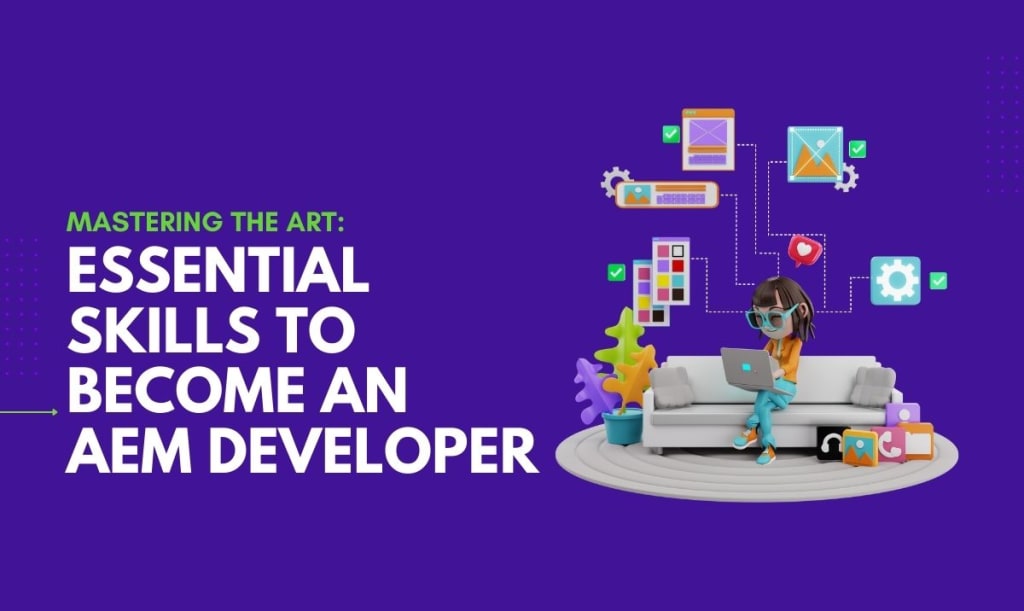Mastering the Art: Essential Skills to Become an AEM Developer
Mastering the Art: Essential Skills for Aspiring AEM Developers

Introduction:
Adobe Experience Manager (AEM) has emerged as a leading content management solution, empowering businesses to create, manage, and optimize digital experiences. Behind the scenes of AEM’s robust functionalities lies the expertise of AEM developers, who craft seamless digital experiences. Becoming an AEM developer requires a diverse skill set that blends technical prowess with creative problem-solving. In this blog, we’ll delve into the essential skills needed to embark on the journey of becoming an AEM developer.
Proficiency in Java Development:
At the heart of AEM lies Java, a powerful programming language known for its versatility and scalability. A solid understanding of Java is indispensable for AEM development, as many of its core functionalities are built on Java frameworks like Apache Sling and Apache Felix. AEM developers should be proficient in Java development, including concepts such as object-oriented programming, multithreading, and exception handling.
Understanding of Web Technologies:
A strong grasp of web technologies is fundamental for AEM development. This includes HTML, CSS, and JavaScript, the building blocks of web development. AEM developers must be proficient in crafting responsive and user-friendly web interfaces, leveraging CSS frameworks like Bootstrap and JavaScript libraries like jQuery to enhance user experiences.
Familiarity with AEM Architecture:
A thorough understanding of AEM architecture is essential for effective development. AEM follows a component-based architecture, where content is stored and managed in the form of reusable components. Developers should be familiar with AEM’s core concepts such as Content Repository (CRX), OSGi framework, and Apache Jackrabbit, which underpin its architecture.
Mastery of AEM Core Components:
AEM offers a rich set of core components that streamline the development process. AEM developers should be proficient in leveraging these components to build dynamic and modular web applications. This includes components for content authoring, navigation, forms, and multimedia integration. Mastery of AEM core components enables developers to create scalable and maintainable solutions.
Experience with AEM Development Tools:
AEM development is facilitated by a range of specialized tools and utilities. Developers should be familiar with tools like Adobe Experience Manager Desktop App, Adobe Developer Console, and AEM Developer Tools for Eclipse. These tools streamline development workflows, enabling developers to build, test, and deploy AEM applications more efficiently.
Knowledge of Content Management Systems (CMS):
AEM is a robust CMS that empowers businesses to manage digital content effectively. AEM developers should have a solid understanding of content management principles, including content modeling, workflow management, and versioning. Proficiency in AEM’s authoring environment is crucial for developing user-friendly content management solutions.
Problem-Solving and Troubleshooting Skills:
AEM development often involves tackling complex challenges and debugging intricate issues. AEM developers should possess strong problem-solving and troubleshooting skills, enabling them to identify and resolve issues efficiently. This includes proficiency in debugging tools, log analysis, and error handling techniques.
Understanding of Integration and Extensibility:
AEM is designed to integrate seamlessly with other Adobe products and third-party systems. AEM developers should have a deep understanding of integration patterns and protocols, including RESTful APIs, SOAP web services, and OAuth authentication. Additionally, proficiency in AEM’s extensibility mechanisms, such as custom workflows, servlets, and services, is crucial for building tailored solutions.
Knowledge of Best Practices and Performance Optimization:
AEM development requires adherence to best practices and performance optimization techniques to ensure the scalability and efficiency of applications. Developers should be familiar with AEM coding standards, security guidelines, and performance tuning strategies. This includes optimizing asset delivery, minimizing server round trips, and caching content effectively.
Continuous Learning and Adaptability:
The field of AEM development services is dynamic and constantly evolving. AEM developers should demonstrate a commitment to continuous learning and adaptability, keeping pace with the latest trends and updates in AEM technology. This includes participating in developer communities, attending conferences, and pursuing certifications to enhance skills and knowledge.
Conclusion:
Becoming an AEM developer requires a multifaceted skill set that encompasses Java development, web technologies, AEM architecture, and content management principles. By mastering these essential skills and embracing continuous learning, aspiring AEM developers can embark on a rewarding journey of creating immersive digital experiences with Adobe Experience Manager.
About the Creator
Surekha Tech
Surekha Technologies is a leading development and consulting company in California, USA. We offer end-to-end services For Digital Portal platform, Liferay, Odoo Development, Enterprise Mobile Applications Development.
Enjoyed the story? Support the Creator.
Subscribe for free to receive all their stories in your feed. You could also pledge your support or give them a one-off tip, letting them know you appreciate their work.






Comments
There are no comments for this story
Be the first to respond and start the conversation.